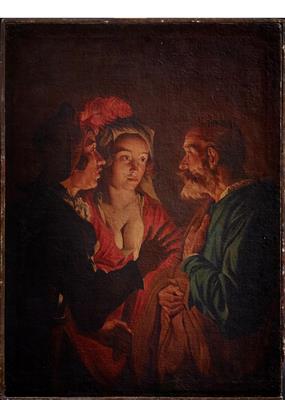Mathias Stom

(Amersfoort circa 1600 – circa 1652 Sicily?)
The Denial of Saint Peter,
oil on canvas, 134.7 x 99.5 cm, framed
Provenance:
European aristocratic collection, late 17th Century;
and thence by descent to the present owner
We are grateful to John Gash for confirming the attribution of the present painting on the basis of a photograph.
The Denial of Saint Peter displays the spirited brushwork and broad, painterly approach that is characteristic of Stom’s style. The painting can be dated to the artist’s maturity, either to Rome in the early 1630s or to Naples in the mid-1630s. The drama of the Biblical subject is heightened through the close-up composition, the intense chiaroscuro and complementary colour contrasts. Further dynamics and tension are created through the use of different compositional lines, the two male figures are shown in profile, the woman in the centre is shown turned in a three-quarter figure. The hand postures of the two male figures are mirrored, thereby creating a self-contained compositional group.
The atmospheric light and shadow effects are created by the central pictorial artificial light source. The male figure on the left holds a torch in his left hand, however, the light is masked by his right hand, thereby light and shadow deliberately distort the protagonists features to produce a theatrical effect.
The depiction of artificial candlelight became a hallmark of Northern Caravaggesque painting. Among the first representations of nocturnal scenes are Tintoretto’s notturni with monumental figurative groups. However, the nature of the Caravaggesque movement demanded a more naturalistic and intimate approach to the subject, which was found in the work of Jacopo Bassano. Many Bassanesque nocturnal pictures were reaching Rome by the turn of the century and had a strong impact on a generation of Northern artists, who travelled to Italy to complete their training.
Originally from the Netherlands, Matthias Stom, following in the footsteps of many Northern painters of his day, travelled to Rome where he is first recorded in 1630, aged 30. This journey south of the Alps, probably initially envisaged as a formative experience by the young painter, eventually became permanent and the artist never returned home, moving instead to Naples around 1633 and after 1640 to Sicily, before eventually settling in Northern Italy. Stom belongs to a generation of Netherlandish painters on whom the work of Caravaggio made a profound and enduring impact. Discarding the artificiality of late Mannerism, these artists adopted an uncompromising realism, employing powerful close-up compositions and Caravaggio’s celebrated tenebrism, created by the dramatically contrasted treatment of light and shade.
Expert: Mark MacDonnell
 Mark MacDonnell
Mark MacDonnell
+43 1 515 60 403
oldmasters@dorotheum.com
10.11.2021 - 16:00
- Odhadní cena:
-
EUR 200.000,- do EUR 300.000,-
Mathias Stom
(Amersfoort circa 1600 – circa 1652 Sicily?)
The Denial of Saint Peter,
oil on canvas, 134.7 x 99.5 cm, framed
Provenance:
European aristocratic collection, late 17th Century;
and thence by descent to the present owner
We are grateful to John Gash for confirming the attribution of the present painting on the basis of a photograph.
The Denial of Saint Peter displays the spirited brushwork and broad, painterly approach that is characteristic of Stom’s style. The painting can be dated to the artist’s maturity, either to Rome in the early 1630s or to Naples in the mid-1630s. The drama of the Biblical subject is heightened through the close-up composition, the intense chiaroscuro and complementary colour contrasts. Further dynamics and tension are created through the use of different compositional lines, the two male figures are shown in profile, the woman in the centre is shown turned in a three-quarter figure. The hand postures of the two male figures are mirrored, thereby creating a self-contained compositional group.
The atmospheric light and shadow effects are created by the central pictorial artificial light source. The male figure on the left holds a torch in his left hand, however, the light is masked by his right hand, thereby light and shadow deliberately distort the protagonists features to produce a theatrical effect.
The depiction of artificial candlelight became a hallmark of Northern Caravaggesque painting. Among the first representations of nocturnal scenes are Tintoretto’s notturni with monumental figurative groups. However, the nature of the Caravaggesque movement demanded a more naturalistic and intimate approach to the subject, which was found in the work of Jacopo Bassano. Many Bassanesque nocturnal pictures were reaching Rome by the turn of the century and had a strong impact on a generation of Northern artists, who travelled to Italy to complete their training.
Originally from the Netherlands, Matthias Stom, following in the footsteps of many Northern painters of his day, travelled to Rome where he is first recorded in 1630, aged 30. This journey south of the Alps, probably initially envisaged as a formative experience by the young painter, eventually became permanent and the artist never returned home, moving instead to Naples around 1633 and after 1640 to Sicily, before eventually settling in Northern Italy. Stom belongs to a generation of Netherlandish painters on whom the work of Caravaggio made a profound and enduring impact. Discarding the artificiality of late Mannerism, these artists adopted an uncompromising realism, employing powerful close-up compositions and Caravaggio’s celebrated tenebrism, created by the dramatically contrasted treatment of light and shade.
Expert: Mark MacDonnell
 Mark MacDonnell
Mark MacDonnell
+43 1 515 60 403
oldmasters@dorotheum.com
|
Horká linka kupujících
Po-Pá: 10.00 - 17.00
old.masters@dorotheum.at +43 1 515 60 403 |
| Aukce: | Obrazy starých mistrů |
| Typ aukce: | Sálová aukce s Live bidding |
| Datum: | 10.11.2021 - 16:00 |
| Místo konání aukce: | Wien | Palais Dorotheum |
| Prohlídka: | 29.10. - 10.11.2021 |
Všechny objekty umělce
